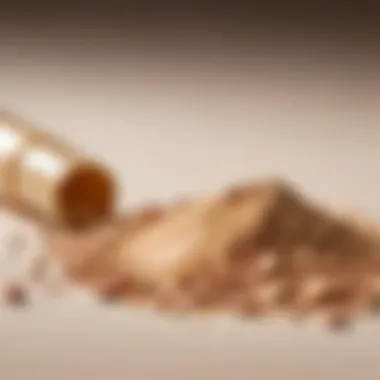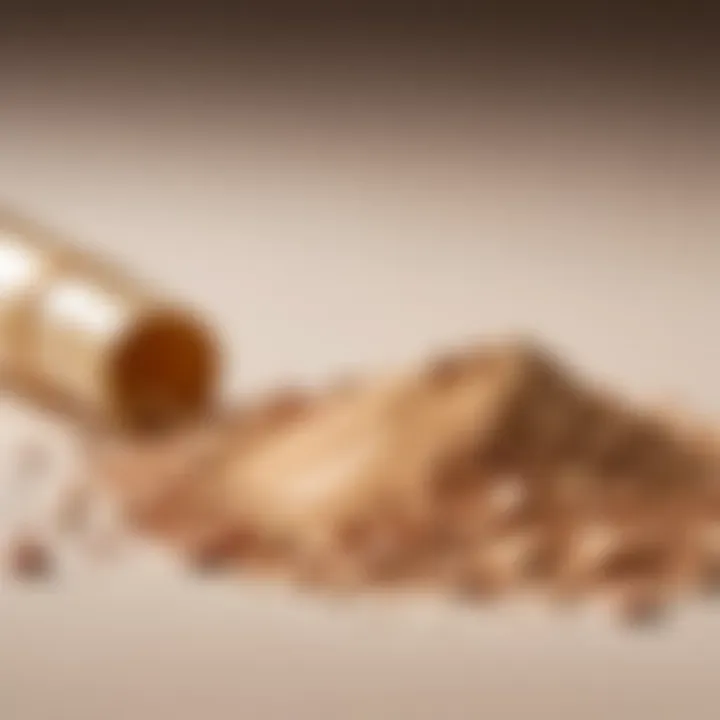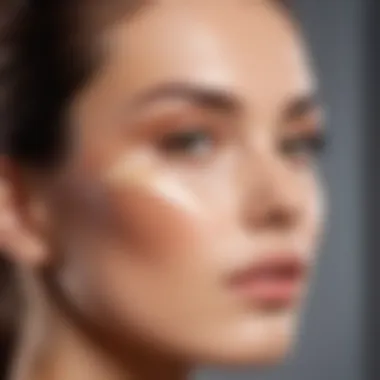Crafting Natural Concealer at Home: A DIY Guide


Intro
In recent years, there has been a growing interest in natural beauty products. This includes a particular focus on creating cosmetics at home, especially concealers. Making natural concealer is not only a way to ensure that the ingredients used are kind to the skin, but it also gives one the power to customize their own products according to personal preferences and needs.
Crafting a natural concealer at home is an accessible endeavor. It can serve various skin types and issues, from redness to dark circles. Moreover, understanding how to formulate these products can lead to a more holistic approach to beauty—one that respects health alongside aesthetics.
This section serves as an introduction to the process of creating a natural concealer at home. In the following parts, we will discuss the ingredients you might consider, the benefits of these natural solutions, as well as techniques to craft your custom concealer.
Ürün İncelemesi
Ürün Tanıtımı
When delving into homemade concealers, the focus should be on natural components. Common items used include shea butter, coconut oil, and mineral pigments. These ingredients are not only effective in providing coverage but also nurturing for the skin.
The main advantage of making your own concealer is knowing exactly what goes into it. Many commercial products contain synthetic chemicals that can irritate the skin or cause breakouts. In contrast, a natural concealer allows users to avoid such additives.
Ürün Özellikleri
The core attributes of a natural concealer include:
- Customizability: Tailor formulations to personal skin tone and type.
- Non-toxic ingredients: Preferable over potentially harmful chemicals.
- Nutritional benefits: Ingredients like shea butter can hydrate and soothe the skin.
Güzellik İpuçları
Doğal Güzellik Yöntemleri
Utilizing natural concealers fits into a broader trend of opting for organic and holistic beauty methods. Simple techniques can enhance the application experience:
- Patch Test: Always test a small area of skin before applying your formula widely to ensure no adverse reactions occur.
- Layering: For better coverage, consider applying concealer in thin layers, allowing each layer to dry before adding more.
Sağlıklı Beslenme ve Güzellik
Beauty extends beyond topical solutions. Healthy diet plays an important role in skin health. Some important tips include:
- Eating plenty of fresh fruits and vegetables that are high in antioxidants can improve skin condition.
- Consuming healthy fats, like those found in avocados and nuts, supports skin hydration.
"A balanced diet is the foundation of healthy skin; natural beauty begins from within."
Foreword
The art of crafting personal beauty products is gaining momentum. The importance of this topic lies in the growing awareness of what goes into cosmetics. Many people are making a conscious choice to avoid synthetic chemicals in favor of more natural ingredients. This article delves into the journey of creating a natural concealer at home, combining practicality with the flair of self-expression.
Natural concealers can serve a dual purpose. They cover skin imperfections while ensuring that skin health is not compromised. The benefits extend to both user satisfaction and environmental considerations. Exploring how to create a concealer at home allows individuals to customize their products according to personal preferences, skin types, and specific needs. It harnesses the power of natural ingredients, leading to formulations that are often gentler on the skin.
"The shift towards natural cosmetics is not just a trend but a response to the growing demand for transparency in beauty products."
This introduction sets the stage for an extensive exploration of natural cosmetics with a focus on crafting concealers. By understanding the key concepts and benefits, readers can appreciate the subsequent discussions on ingredients, techniques, and application methods.
Benefits of Natural Concealers
Natural concealers offer multiple advantages over traditional cosmetic alternatives. The importance of using natural products fundamentally lies in their ability to benefit both the skin and the environment. As consumers become more aware of what they apply on their skin, natural concealers emerge as appealing options due to their minimalistic and often nourishing ingredients. They provide effective coverage while promoting skin health, an essential aspect for those who are conscious of their beauty choices.
Skin Compatibility
One significant benefit of natural concealers is their compatibility with various skin types. Most traditional concealers contain synthetic compounds that can irritate sensitive skin. In contrast, natural concealers use ingredients like coconut oil, shea butter, and beeswax, which are known for their soothing properties.
- Hypoallergenic: Many natural ingredients are less likely to cause allergic reactions, making them suitable for those with allergies or sensitive skin.
- Nourishing: Ingredients like shea butter and coconut oil not only conceal blemishes but also provide hydration. This helps in maintaining skin elasticity and softness.
- Customizable: When creating natural concealers at home, individuals can tailor formulations to fit personal skin concerns, whether dryness, oiliness, or breakouts. This customization enhances the overall user experience and efficacy.
Using natural concealers can significantly reduce the likelihood of experiencing breakouts or irritation on the skin, thus allowing users to feel more confident in their daily skincare and beauty routine.
Environmental Considerations
The environmental impact of cosmetic products is a growing concern today. Traditional cosmetics often contain harmful chemicals, and their production processes can be damaging to ecosystems. Natural concealers contribute positively to the environment for several reasons:
- Biodegradable Ingredients: Most natural concealers utilize ingredients that are biodegradable and environmentally friendly.
- Eco-friendly Packaging: DIY natural concealers can often be stored in reusable containers, minimizing waste compared to mass-produced cosmetics.
- Sustainability: Many natural ingredients can be sourced sustainably, which aligns with eco-conscious consumer values.
Using natural cosmetics not only enhances your personal beauty but also supports a healthier planet. This dual benefit underscores the importance of adopting natural solutions in your skincare routine.
Ingredients for DIY Concealer
The ingredients for creating a natural concealer are vital for both the effectiveness of the product and the health of the skin. Choosing the right components ensures that the concealer provides adequate coverage while being gentle on the skin. Furthermore, understanding the properties of each ingredient can significantly impact the performance and feel of the final product. In this section, we will explore the base ingredients and coloring agents that can be used in homemade concealers. Each has unique benefits and potential drawbacks that are essential to consider when crafting your concealer.
Base Ingredients


Coconut oil
Coconut oil is a versatile ingredient widely appreciated for its moisturizing properties. It is an excellent option in concealer formulations due to its ability to hydrate the skin. With a smooth consistency, it aids in achieving an even application. Coconut oil's high fat content can also provide a barrier that helps other components adhere better to the skin. While it is effective, some people may find coconut oil too heavy or prone to clogging pores, which can lead to breakouts. Therefore, individuals with acne-prone skin should use it cautiously, perhaps blending it with lighter oils.
Shea butter
Shea butter is renowned for its rich, creamy texture and nourishing effects on the skin. It is packed with vitamins A and E, making it a popular choice for skin care products, including concealers. Shea butter provides excellent coverage and a moisturizing component that can help smooth out imperfections. The natural compounds in shea butter may also promote skin healing, which is an added benefit for those with blemishes. However, its density can sometimes lead to a heavier feel on the skin, so it should be balanced with other lighter ingredients if lighter formulations are desired.
Beeswax
Beeswax serves as both a thickener and a protective agent in homemade concealer. It is unique for its ability to solidify mixtures, providing structure and stability to the product. Beeswax also forms a protective barrier on the skin, helping to lock in moisture. This quality makes the concealer more resilient, preventing it from sliding off the skin during the day. On the downside, beeswax can make the application process a bit challenging if not combined with sufficient oils to ensure smoothness. Users should also ensure that they are not allergic to bee products before using it in their formulations.
Coloring Agents
Cacao powder
Cacao powder is not just a delicious addition to recipes; it also provides a natural pigment that can be used in DIY concealers. Its warm brown tones can help cover imperfections and dark circles. Cacao powder is beneficial for its natural sourcing and can be easily adjusted for color intensity. However, without proper blending, its grainy texture might affect the final smoothness of the concealer, requiring careful mixing techniques to avoid lumps.
Turmeric
Turmeric is well-known not just for its culinary uses but also for its skin benefits. It has anti-inflammatory properties and gives a yellow hue, which can effectively counteract purple-toned blemishes or dark circles. Incorporating turmeric into concealer can help take advantage of its health benefits, although it must be used in moderation. Overuse may lead to an overly yellow tint that can be difficult to correct, particularly for certain skin tones.
Matcha
Matcha, while often recognized for its vitality-boosting properties in beverages, also acts as an excellent coloring agent. Its green tint can neutralize redness and can be particularly effective for those who often deal with skin issues related to sensitivity or rosacea. Matcha adds not only color but also additional antioxidants that are great for skin health. Remember, a little goes a long way; excessive matcha can turn the concealer green, which may not suit all skin tones.
Important Note: When combining various ingredients, always conduct a patch test to check for skin reactions. It is prudent to tailor the formulation according to individual skin types and sensitivities.
Tools Required
The creation of natural concealer at home is not solely dependent on the ingredients, but also on the tools utilized throughout the process. Having the right tools is essential for achieving a smooth, effective product. The proper equipment ensures that all components blend well together, and makes the application process more efficient. Beyond usability, these tools can influence the quality and texture of the final product.
Essential Equipment
Mixing bowl
The mixing bowl is a fundamental component in the DIY process of making natural concealer. This tool is where all the ingredients come together, allowing for thorough mixing and blending. A good mixing bowl typically has a wide opening and a sturdy construction that can accommodate both solid and liquid ingredients without spilling. This feature allows for easier manipulation of the mixture, contributing to a uniform texture. In this article, a glass or stainless steel mixing bowl is suggested due to their ease of cleaning and durability. Plastic bowls can retain odors or colors from previous uses, which is not desirable in cosmetic preparations.
Measuring spoons
Accurate measurements are critical when preparing any cosmetic formulation, including natural concealer. Measuring spoons offer precision, ensuring the right balance of ingredients is achieved. This tool commonly comes in sets, providing various sizes that can be used for both dry and wet components. The prime characteristic of high-quality measuring spoons is their marked measurements that allow for easy reading. Using this equipment helps avoid errors that could lead to an imbalanced concealer, which may affect its effectiveness. One should avoid using kitchen utensils that are not specifically made for measuring, as they can lead to inconsistency in the formulation.
Containers
Once the natural concealer is made, appropriate storage is crucial for preserving its integrity. Containers, ideally made of glass or high-grade plastic, are favored for their ability to protect the product from light and contamination. A good container keeps the concealer secure and extends its shelf life. Containers should also be opaque to prevent light from degrading the ingredients within. Lastly, it is important to choose a container that is easy to open and close, as frequent access will be required during daily application.
Safety Gear
Ensuring safety while creating natural cosmetics cannot be overstated. The right gear protects the creator from exposure to potentially irritative components in the ingredients, thus fostering a safer, more conscientious crafting environment.
Gloves
Wearing gloves serves as a primary protective measure when making natural concealer. Gloves not only keep one's hands clean but also safeguard against the absorption of substances that might irritate the skin. When selecting gloves, latex or nitrile options are recommended due to their durability and comfort. An important characteristic of these gloves is their elasticity, which allows for precise movements while mixing and measuring ingredients. Some may prefer powder-free options to reduce the risk of allergies. However, if someone has a known allergy to latex, choosing nitrile is the more appropriate option.
Mask
Using a mask while working with powdered ingredients is another critical precaution. Masks help reduce inhalation of fine particles, especially when mixing colorants like cacao powder or turmeric. A mask also provides an additional barrier against any scents that may be off-putting. There are many types of masks on the market, but a simple surgical mask can suffice for this purpose. Its lightweight nature makes it comfortable to wear during the preparation process. The key aspect of the mask is its filtration capabilities, aiming to reduce the inhalation of any allergens or irritants that might otherwise seep into the user's system.
Step-by-Step Guide to Making Natural Concealer
Making your own natural concealer at home requires a clear process to ensure the outcome meets your expectations. This section emphasizes the significance of a systematic approach to creating your bespoke cosmetic solution. Following a step-by-step guide offers the advantage of minimizing errors and enhancing the satisfaction of the final product. The art of concealer crafting combines practical skill with personal customization, which caters to individual skin tones and preferences. Thus, this guide serves as a blueprint, facilitating both beginners and those more experienced in DIY cosmetics.
Preparation Stage
Gathering materials
Gathering materials forms the backbone of any successful DIY endeavor. This aspect is crucial as it sets the foundation for the entire process. A thorough collection of necessary items contributes to efficiency and flow when creating natural concealer. Common materials typically include coconut oil, shea butter, and beeswax, alongside additional colorants like cacao powder and turmeric. Each component has a role, providing coverage while ensuring the product remains skin-friendly. The careful selection of these materials can ensure better texture and application, hence improving the overall quality of your concealer.
Furthermore, opting for natural ingredients can be beneficial, as they usually have fewer side effects compared to chemical-laden commercial products. However, it is vital to check for potential allergies before using any ingredient. Being organized in this phase yields good rewards in the execution stage.
Setting up the workspace
Setting up your workspace is equally important, allowing for an organized environment while crafting your concealer. A well-arranged workspace helps streamline processes, reducing distractions that might lead to mistakes. This preparation includes cleaning surfaces and laying out all materials and tools, ensuring everything is accessible.
The significance of this setup lies in creating a conducive atmosphere for creativity and precision. Clear space also contributes to safety, as it minimizes the risk of accidents. Consider using protective coverings for your work area to prevent stains. While this aspect may seem minor, it has strong implications for both efficiency and cleanliness in the process.


Mixing the Ingredients
Melting base ingredients
Melting base ingredients is a pivotal stage in making your natural concealer. Typically, this involves gently heating ingredients such as coconut oil and shea butter until they reach a liquid state. This step allows for easier blending of the materials, creating a homogeneous mixture. The clarity of application improves with well-combined ingredients, yielding a smoother texture in the final product.
The key characteristic of melting is the ability to control the temperature and ensure none of the ingredients lose their beneficial properties. Slow and careful heating is highly recommended. Alternatively, overheating could lead to spoilage or changes in texture. This temperature control is vital for achieving a product that balances effectiveness and skin-nourishing properties.
Incorporating colorants
Incorporating colorants is where personalization comes to life. Adding ingredients like cacao powder or turmeric provides not just color but also benefits such as anti-inflammatory properties, depending on your choice. This step allows you to adjust the hues to match your individual skin tone or specific covering needs.
The defining feature of this process is experimentation. The choose of colorant can influence not only the shade but also the overall feel of the concealer on the skin. This is an artistic process that allows for creating a blend perfectly suited to your needs, making this stage a highlight in the concealer crafting journey.
Cooling and Storing
Pouring into containers
Pouring into containers is the final move before your concealer can be used. This step involves transferring your mixture from the mixing bowl into suitable storage jars. The chosen containers should be clean and preferably dark or opaque to protect the contents from light exposure.
The key to this stage is ensuring a mess-free transfer, maintaining the integrity of your carefully crafted formulation. Suitable containers not only preserve the consistency of the product but also make application easier down the line. Thus, it is advisable to consider practical and stylish storage options that align with your aesthetic preferences.
Allowing to set
Allowing to set is the concluding phase that solidifies your hard work. After pouring, it’s essential to give the concoction time to cool and solidify. This usually takes a few hours, but depending on the ambient temperature, it could require more or less time. The unique feature of this phase is its flexibility; you can leave your concealer to set in the fridge for a firmer result.
The advantage of allowing to set not only lends to a quality texture but also ensures the ingredients bond properly, enhancing the overall performance upon application. This phase cannot and should not be rushed, as it ensures the durability of the concealer, impacting its shelf life and effectiveness.
Customizing Your Concealer
Customizing your concealer is a crucial aspect of crafting a natural product that effectively meets individual needs. This section explores how personalization adds value to your beauty routine. Tailoring the shade and scent allows for greater control over the final result, providing solutions that align with personal preferences and skin types. As skin tones vary widely, customizing your concealer can enhance coverage and create a flawless finish. Moreover, adding essential oils offers potential therapeutic benefits, making the product not only functional but also pleasant to wear.
Adjusting Shades
Adjusting shades when creating concealer is essential to achieving the perfect match for your skin tone. Shade customization allows users to blend multiple coloring agents to find their ideal hue. Cacao powder, turmeric, and matcha can be combined in unique proportions. For a more light or dark shade, you can increase or decrease the predominant ingredient accordingly.
When selecting shades, consider the undertone of your skin. Identifying warm, cool, or neutral undertones helps in achieving a natural appearance. Always test on a small area of the skin to see how the shade adapts to the natural color. A cosmetic color wheel can aid in visualizing potential blend possibilities.
Adding Scent or Essential Oils
Incorporating scent or essential oils into your concealer can enrich the overall experience. Selecting suitable essential oils adds a delightful fragrance as well as offers skin benefits. For instance, lavender oil provides calming properties, which can be beneficial for sensitive skin.
When adding essential oils, proceed with caution. A little goes a long way, and overdoing it can lead to skin irritation. Always perform a patch test prior to full application to ensure compatibility with your skin. Create a well-balanced final product by mixing oils that complement each other and enhance the intended benefits.
Customizing your concealer not only makes it uniquely yours but also enhances both the application and results.
Application Techniques
Application techniques are critical in ensuring that your natural concealer achieves the desired effect. The way a concealer is applied can greatly influence its coverage, blending, and overall finish. Mastering the various methods of application can transform not just the appearance but also how the concealer interacts with skin texture and imperfections.
Understanding these techniques allows individuals to highlight or minimize features in a way that appears natural and seamless. As such, the right tools and methods for application are central to the effectiveness of homemade concealers.
Tools for Application
Brushes
Brushes are often favored for their precision in applying concealer. A good brush allows for intricate work around the eye area and is especially beneficial when covering small blemishes. The key characteristic of brushes is their variety in shapes and sizes, which allows for different coverage techniques. A flat brush is useful for applying on larger areas, while a finer brush can target specific spots.
The unique feature of brushes lies in their ability to deposit the product evenly with a slight dabbing motion. This can lead to better coverage without over-applying product. However, brushes require regular cleaning to maintain hygiene and prevent bacteria build-up.
Fingers
Using fingers for application provides a very personal and intimate approach to concealer application. The warmth of the fingers helps in blending the product naturally into the skin. This method is particularly beneficial for dry areas, as fingers can gently warm the concealer, making it easier to spread and absorb.
The unique feature of applying concealer with fingers is the direct connection to the skin, allowing the user to gauge pressure and coverage instantly. However, the downside is that it may not provide as refined an application as brushes, especially in areas needing precision.
Sponges
Sponges have gained popularity thanks to their ability to blend concealer seamlessly into the skin without leaving streaks. They are particularly effective for achieving a more diffused look that mimics natural skin texture. The key characteristic of sponges is their ability to absorb excess product, which can prevent a cakey appearance.
A unique aspect of using sponges is the different shapes available; some are pointed for precise application while others are rounded for larger areas. The disadvantage, however, is that sponges can absorb more product than brushes or fingers, which may lead to faster usage of the concealer.
Techniques for Best Results


Dabbing
Dabbing refers to the method of lightly placing the concealer onto the skin and gently tapping it in place. This technique is critical for achieving the most natural look. The key characteristic of dabbing is its ability to create a soft, airbrushed effect, making it perfect for sensitive areas like under the eyes.
This method allows for controlled coverage, enabling users to build up layers where necessary without making the concealer look heavy. The disadvantage could be that dabbing can sometimes consume more time, requiring patience for those who prefer a quicker makeup routine.
Blending
Blending is the process of merging the concealer with the skin to achieve a smooth transition between the concealer and surrounding areas. The key characteristic of blending is its pivotal role in ensuring that no harsh lines remain visible. A well-blended concealer provides a polished finish, making imperfections practically undetectable.
The unique feature of blending lies in its versatility; it can be done with various tools—be it brushes, fingers, or sponges—providing flexibility in application. On the downside, blending can become complicated if the concealer dries too fast, leading to patchiness. Thus, it is crucial to blend while the product is still workable.
Using the right tools and techniques elevates the quality of your natural concealer application, making a significant difference in your makeup routine.
Common Issues and Solutions
In the quest to create your own natural concealer, encountering problems is quite common. Various factors can influence the final product, and understanding how to address these issues is essential for achieving the desired results. Problems such as separation or clumping and color mismatch can arise during the crafting process. Addressing these issues effectively ensures that your homemade concealer is not only functional but also meets your beauty needs effectively. An understanding of the common pitfalls allows for a smoother DIY experience and enhances the overall outcome.
Separation or Clumping
Separation or clumping can significantly affect the texture and usability of your natural concealer. This issue often arises when the base ingredients and coloring agents do not combine properly. Factors contributing to this include inconsistent temperatures during the melting and cooling process, as well as the quality of the ingredients used. For instance, if the oils or waxes are not melted adequately, they may not emulsify with the coloring agents, leading to a product that separates or appears lumpy.
To prevent this issue, consider the following steps:
- Ensure Proper Melting: Melt the base ingredients thoroughly. Use a double boiler for more controlled heating.
- Stir Well: While combining the ingredients, ample stirring is crucial. This helps emulsify the components effectively.
- Cool Gradually: Allowing the mixture to cool down slowly ensures that it solidifies uniformly, reducing the chance of separation.
Should clumping still occur, warm the concealer slightly and robustly mix again. This can often salvage the product if the issue was mild. If you consistently experience this problem, reevaluate your ingredient choices, especially the base ingredients.
Color Mismatch
Achieving the correct color for your natural concealer can be tricky. Color mismatch usually happens if the shade does not blend well with your skin tone or does not work as intended for covering imperfections. This issue may arise during the mixing stage, where the proportions of coloring agents to base ingredients are not balanced correctly.
To address color mismatches, you can apply the following strategies:
- Test Small Batches: Before making a large amount, create a small test batch. Apply it on your skin to see how it blends.
- Adjust Gradually: If the color is off, add small amounts of coloring agents gradually until you reach the desired hue.
- Use a Color Reference: Keep a color reference chart handy. This can guide you on where to start when mixing.
- Mixing Methods: Explore different mixing methods if you face ongoing issues. Some methods might yield better results than others, especially with various coloring agents such as turmeric, cacao, or matcha.
By understanding the common issues that can arise during the creation of your natural concealer, you'll be better equipped to face challenges and fine-tune your products for optimal performance.
Shelf Life and Storage
Understanding the shelf life and proper storage of your homemade natural concealer is essential for both optimal performance and safety. Unlike commercial products that may contain preservatives, DIY natural cosmetics rely on the inherent stability of their ingredients. This makes knowing how to store and maintain their freshness critical.
Proper storage helps extend the life of your concealer, ensuring the ingredients retain their effectiveness. Exposure to light, heat, and moisture can alter the formulation. As a result, knowing how to manage these factors is crucial to preserve the quality and function of your product.
Best Practices for Longevity
To enhance the shelf life of your natural concealer, consider implementing the following practices:
- Choose Airtight Containers: Store your concealer in air-tight jars or tubes. Using containers that limit exposure to outside air slows down oxidation and spoilage.
- Keep It Cool: A cool environment is essential. Store your concealer in a dark cupboard or a refrigerator. This can help stabilize oils and prevent them from going rancid.
- Avoid Direct Sunlight: Exposure to sunlight can degrade materials over time. Always keep your concealer away from direct sunlight to maintain its quality.
- Use Clean Tools: When applying your concealer, ensure your brushes or fingers are clean. This minimizes the risk of introducing bacteria to the product.
Signs of Spoilage
Regularly check your natural concealer for signs of spoilage. Some key indicators to watch for include:
- Unpleasant Odor: If your concealer has developed a strange smell, this often signals that the oils have gone rancid. Discard it immediately.
- Discoloration: Any noticeable change in color could indicate that the pigments are breaking down, compromising the quality.
- Texture Changes: If the texture becomes overly thick, clumpy, or separates, it’s best to err on the side of caution and throw it away.
Regular maintenance of your natural concealer not only enhances its longevity but also ensures that you consistently achieve the desired coverage without compromising on safety.
By following these best practices and remaining vigilant about potential signs of spoilage, your homemade concealer can remain a reliable part of your beauty routine. Knowing how to properly store and understand the lifespan of your product is vital for effective use.
Closure
In the process of creating a natural concealer at home, it is vital to recognize the broader implications of this practice. Emphasizing natural ingredients not only offers personal benefits, but it also aligns with growing consumer interest in environmentally conscious choices. The focus on health-driven products has become increasingly significant in a world where synthetic compounds can lead to adverse reactions.
One key element discussed in this article is the flexibility in crafting a concealer tailored to individual needs. This customization empowers users, offering them the ability to select shades and ingredients suitable for their unique skin types. Such personalization is particularly crucial in a cosmetic landscape often dominated by one-size-fits-all solutions.
Additionally, the article highlights the importance of understanding the ingredients used. Knowledge about the properties of base ingredients like coconut oil and shea butter, as well as natural coloring agents such as cacao powder and turmeric, enhances users’ ability to create effective and safe products. By becoming informed consumers, readers can make choices that benefit both their skin and the planet.
Lastly, this exploration of DIY concealer serves as a valuable reminder of the joy of experimentation in the realm of beauty. Engaging in the crafting process not only invites creativity but also fosters a deeper connection to the products used daily.
"Creating your own cosmetics is not merely an act of self-care; it transforms your relationship with beauty, prioritizing authenticity and health."
Recap of Key Points
- Natural concealers provide safer alternatives to commercially produced options, reducing exposure to harmful chemicals.
- Customizing your concealer based on individual skin tones and types can lead to better results and satisfaction.
- Ingredients like coconut oil and shea butter have beneficial properties for skin health.
- Awareness of sustainability and environmentally friendly practices is increasingly central to beauty choices.
Encouragement for Experimentation
Exploring the process of making a natural concealer can be a deeply rewarding experience. It allows individuals to embrace their creativity while honing in on what works best for their skin. Trying different combinations of ingredients, adjusting shades, or introducing new scent profiles can lead to exciting and personalized results.
Readers are encouraged to take the knowledge gained from this article and experiment confidently. Whether it is your first attempt or you are an experienced DIY enthusiast, each batch you create will enhance your understanding of formulations and skin compatibility. The journey not only improves your skill but also contributes to a more sustainable approach to cosmetics.







